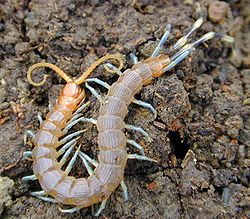Wikijunior:Bugs/Centipede
A work in progress, will update soon -Wes
What does it look like?
[edit | edit source]
Centipedes have between 15 and almost 200 segments, with one pair of legs for each segment. Most centipedes have less than fifty segments, and so less than one hundred legs. They are flat arthropods. The head has two antennae and a pair of mandibles. The furthest forward, or anterior, segment has a pair of venomous claws. The largest known centipede, the Amazonian giant centipede, grows over one foot long. However, the most common centipedes are only a few inches long. A centipede is usually between a brown and a red color. Some types of centipedes are blind.
Where does it live?
[edit | edit source]
Centipedes live all over the world, in South America, North America, Africa, and Europe. Some of the largest centipedes are located in South America (see left). Centipedes prefer moist, dark, and cool habitats. The centipede is mainly a nocturnal creature, but may be seen during the day.
What does it eat?
[edit | edit source]A centipede is a carnivorous creature, and eats prey that is available to it. It is not well known exactly what it eats, but any soft-bodied, reasonably sized creatures are common in the diet. It is believed that for some species of centipedes worms are the main source of food. Some larger species of centipedes can eat reptiles, small mammals, birds, and bats! Some centipedes even eat each other! To kill their prey, a centipede will grab it with its jaws and inject a poisonous bite to kill it.
How does it defend itself?
[edit | edit source]Centipedes have many self-defense mechanisms against predators such as beetles, spiders, and snakes. A centipede can pinch a predator with its back legs or poison an animal with its bite, but it has some more interesting defensive tricks. A centipede can "drop" its legs that are being pinched by a predator and run away, leaving the predator with nothing but a few legs! Some centipedes also emit a gas that can hurt predators. Centipedes also blend into the environment quite nicely, and are very quick! That centipede is one tough arthropod!
What stages of metamorphosis does it go through?
[edit | edit source]
Males deposit a mass that contains the necessary components for reproduction. Males will then court females and lead them to this mass, or leave the mass for a female to find. A female will then take in this mass and get ready to lay eggs. In colder climates, eggs are laid during the spring or summer. In warmer climates however, there seems to be no specific breeding pattern. Around 10-60 eggs are laid, depending on the species. Eggs are laid in the ground or in nests. While some centipedes just bury their eggs, other types will guard the eggs until they hatch. It may take a couple of months before the eggs hatch into larvae. The lifespan of a centipede varies greatly between the different types, but some can live between 5 and 6 years!
What special behavior does it exhibit?
[edit | edit source]Centipedes are indeed quite interesting creatures! The ability to lose legs and kill much larger animals make it very unique. The centipede is also nocturnal, mostly roaming at night. Walking barefoot at night would give me the creeps!
How does this bug affect people?
[edit | edit source]The centipede can be a nuisance as its bites can be painful to humans. There is only one recorded death as a result of a centipede, but the victim was bit in the head. Poisons usually are not strong enough to hurt humans, but some bites can numb, swell, or discolor the skin. If a person is allergic, they should seek medical attention.
